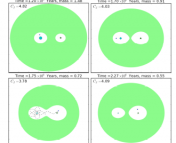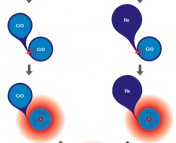Authors: Thomas G. Wilson, Jay Farihi, Boris T. Gänsicke, Andrew Swan
First Author’s Institution: University College London
Status: Accepted for publication in MNRAS (open access on arXiv)
How will it all end?
In another 6 billion or so years, the Sun will run out of fuel, expand and shed its outer layers until only a hot, dense core called a white dwarf remains. Although the expansion of the dying Sun will engulf most of the inner Solar System, it’s unclear what will happen to the terrestrial planets. They could either be engulfed by the Sun, driven to a safer, cooler location or possibly even ejected into interstellar space.
To solve this puzzle, you could wait around for the Sun to die. In a more reasonable amount of time, you could also look for elderly stars that show signs of having recently consumed planet-building materials. This can be done either by observing brightness variations from torn apart planets passing between us and the star or by searching for planet-building material sinking onto the surface of a star. The latter method has been much more successful and is what we will focus on today. White dwarf stars which show signs of infalling planetary material are called ‘polluted white dwarfs’. It turns out that the light produced as super heated planet building material sinks into the star currently provides the most accurate way of determining what faraway planets are made of.
We already have a decent idea of what it looks like when a dying star consumes a planet, but astronomers are not sure why and where it can happen. Is this a common outcome of the stellar life cycle? Will this eventually happen with the Sun? Some white dwarfs come in pairs. Is it the complex gravitational interaction between a pair of stars and a planet that subjects the planet to a firey fate? The paper we are looking at today examines a randomly selected, unbiased collection of white dwarf stars as an attempt to answer these questions.
To find a polluted white dwarf
Even the largest, closest stars are so incredibly small on the sky that they appear as only a point of light. This limits astronomers to only being able to study one observable property of a star: how much of each color of light it emits. The best way to do this is with a spectrograph, but this is slow and expensive to do. You can still learn a lot about a star by simply measuring its brightness with a few different color filters placed in front of the camera. Comparing the brightness of an object between different color bands often provides a surprising amount of information. Properties such as the distance to galaxies, the age of star clusters and even the composition of asteroids can all be determined by comparing the amount of blue and red light coming from an object.

Figure 1: A simulation of an asteroid being tidally disrupted as it enters the Roche limit of a white dwarf. Within a certain distance, the difference in gravitational force due to the star across the object shreds it apart. Taken from Figure 5 in Veras et al. 2016.
A crude but quick way to find white dwarfs that are in the process of destroying their planets is by searching for debris near the star. Any planet or asteroid that gets too close to a white dwarf experiences a strong tidal force that tears it apart. An example of this is shown in Figure 1. As an asteroid (or planet) gets torn to tiny pieces, it emits excessive amounts of infrared light. Because the star (and its debris) appear as nothing more than a tiny point of light, we see the infrared color of the star increase.
The authors of today’s paper use the Spitzer Space Telescope to hunt for debris around 210 white dwarf stars. Out of these targets, 15 of these stars are seen to have a companion star, while the other 195 are alone. The presence of planetary debris is determined using two separate methods. First, the authors measure the excess flux of the stars at a wavelength of 3.6 and 4.5 microns. Second, the authors measure a color excess, which is the difference in brightness of the objects at 3.6 and 4.5 microns compared to a plain, non-debris polluted white dwarf.
The authors assume that most of the non-debris hosting stars should have a similar color and flux excess. Anything with planetary debris should appear as an outlier. The distribution of measured flux and color excesses are shown in Figure 2. From this data, there are seven stars that stand out as having a much larger flux and color excess than the rest (the values lie more than 3 standard deviations away from the average). Interestingly, there are an additional 4 stars with a large flux excess but no abnormal color. These stars turn out to all have been previously studied and can be explained by causes other than planetary debris.

Figure 2: Left: The distribution of measured flux excess at 3.6 (left) and 4.5 (right) microns. There are about 15 stars without 3.6 micron flux measurements, which is why the left histogram is slightly smaller. Right: The distribution of color excess for stars with both 3.6 and 4.5 micron measurements. In both cases, the data follows a normal distribution. Polluted white dwarfs are selected by choosing stars with a flux or color excess 3 standard deviations away from the mean.
The authors also obtained high resolution spectra of 143 of these single white dwarfs using Hubble’s COS. A high resolution spectrum of a star is an extremely reliable way to tell whether there is any planetary material present. 65 out of the 143 white dwarfs for which spectra were obtained showed signs of atmospheric metal pollution, which is most certainly caused by a destroyed planet. Comparing these results with the detection rates from measuring the flux excess makes one thing clear: the majority of stars with debris do not show any excess infrared emission. The authors reason that infrared emission from a debris disk is probably difficult to see unless the disk is oriented face on. The likelihood of finding a disk of material facing us is low and thus, so is the detection rate.
What about the binaries?
Additionally, there were 15 binary white dwarfs measured with Spitzer and 12 observed with Hubble. None of the Spitzer binaries showed an infrared excess, while 8 of the Hubble targets showed evidence of metal pollution. With both telescopes, the debris disk detections rates for single stars and binaries are roughly consistent with each other. This suggests that stellar multiplicity probably doesn’t play a significant role in determining the fate of planets in these systems.
Although the sample size here is not huge, this study is significant because the white dwarfs in this study were chosen to represent a wide range of ages. Previous work has focused on measuring the infrared excess from white dwarfs that are already known to have destroyed planets. Although this helps us understand how planets come to be consumed by the host star, it doesn’t tell us anything about how often this happens. From the initial results of this work, it seems entirely possible for the Earth to suffer such a fate some day.




